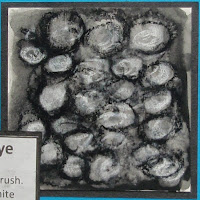Looking at a tin can and my outside wall for their textures!
Tin can: Shiny, metallic, reflective, hard.
 |
| Tin can |
Charcoal: Used a thin stick of charcoal - blended, applied more, smudged some more.
Although a nice effect - may be more appropriate to reflections in the water.
 |
| Tin can in charcoal |
This created an effect that wash too 'wishy-washy', too soft - not reflective or solid.
Neither of these techniques fully captured the metallic texture and look of the tin can.
The outside wall of my house: Soft, rounded, smooth, 'pebbley'.
 |
| Outside wall |
Charcoal: Having thought a rubbing would be the perfect way to recreate the texture. I took newsprint and charcoal and produced a rubbing of the surface.
 |
| Texture 1 - outside wall |
Pencil: I used a soft, dark, smudgy pencil for the cement, and a harder, lighter pencil for the pebbles.
 |
| Texture 2 - outside wall |
Watercolour wash 1: A light grey wash was applied to the paper. Using a damp brush - colour was lifted out from the damp paint. Soft black pastel was applied while the paint was drying.
 |
| Texture 3 - outside wall |
Watercolour wash 2: Grey watercolour wash applied to paper. The end of a pencil dipped in bleach removed the colour in places. Black pastel brushed into the damp paint applied at the end.
 |
| Texture 4 - outside wall |
Watercolour dye: The wash this time was very dark black. Bleach was applied with a brush. Black and white pastel was added when dry.
 |
| Texture 5 - outside wall |
The bleach again played havoc with the paint - all definition and differentiation was lost.
Pastel saved the day!
A page of all the textures created:
 |
| Final page of the texture sketches |
I enjoyed creating the textures - although I found it harder than when working with photographs.
Having drawing implements and paper with you means you can work in a spontaneous way.
If uninspired - just work away. Something will always happen. Recording shapes, textures or feelings means you always have a reference to use at a later date.
Don't just attempt something once, constantly the best piece appeared after the 2nd or 3rd sketch.
No comments:
Post a Comment